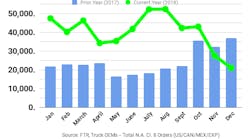North American Class 8 orders in December were the lowest in more than a year, according to two research firms that track the trucking industry. But 2018's Class 8 orders crushed a 14-year industry record for heavy-duty truck orders.
Preliminary net order data show the industry booked 21,300 units in December, down 24% sequentially from November and 43% from December 2017, according to ACT Research. FTR reported even fewer sales (21,000), which it noted was the smallest monthly order since August 2017.
December order activity was as expected, according to FTR vice president Don Ake, with fleets ordering to secure a dwindling number of available build slots in the second half of 2019. There are not many build slots remaining for 2019, so expect orders totals to remain low the next several months.
Backlogs will continue to fall but will remain lofty at the beginning of 2019. Class 8 orders for the past 12 months have now totaled 482,000 units, according to FTR’s numbers; while ACT has the annual total at 490,100.
Complete industry data for December, including final order numbers, will be published by ACT in mid-January. “For all of 2018, Class 8 orders totaled 490,100 units, far outstripping the previous annual order tally set in 2004 at 390,000 units, with orders averaging 40,800 units per month last year,” said Kenny Vieth, ACT’s president and senior analyst. “Owing to its status as the strongest order month of the year, seasonal adjustment is always unkind to Class 8 orders in December, dropping the month’s volume to a 25-month low of 17,300 units.
“It is important to put slowing orders into context. With a 300,000-plus unit backlog and a solidly booked build schedule, the drop in orders is in line with expectations.”
Ake of FTR said: “Order rates right now are not that relevant because of the record-breaking totals recorded in June and July last year. Fleets got a jump on ordering to reserve 2019 build slots, so orders had to fall off at some point, and December was the start of it.”
But orders are different from actual production.
“Because orders rates are reduced, they are not currently a good barometer of long-term demand,” Ake said this week. “All the orders are in, the question now is how many of these orders will actually be built? We will have to watch the build rates and retail sales closely for clues about the future strength of the Class 8 market.”
FTR is forecasting freight growth to ease from its 2018 peak, he said, while remaining vibrant for the first have of 2019. “At some point, the economy and freight growth will moderate and truck builds will decline,” Ake said. “Then order cancellation rates will rise.”
Medium duty
After robust orders in November, Classes 5-7 truck orders declined into the end of the year, falling to a six-month low of 21,500 units — a considerable drop from the 25,200 unit-per-month average the medium-duty industry saw in 2018, according to ACT.
“Seasonality is not a factor in December for medium-duty vehicles, but the month’s orders had the ignominy of being the first negative year-over-year comparison in 15 months, falling 4.6% compared to December 2017,” Vieth said.





